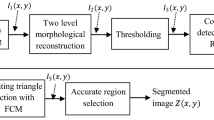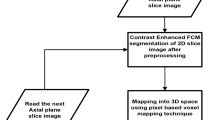Abstract
Brain tumors are most aggressive kind of diseases, if left untreated may lead to very short life expectancy. Assessment of these tumors is usually done by Magnetic Resonance Imaging (MRI), but MRI produces large amount of data which rule out the manual segmentation in the stipulated time, also restricts the use of accurate quantitative evaluation in the clinical practice. So a reliable and automatic segmentation approach is required. Tumor segmentation in MRI brain image is a basic task in many computer vision problems. A typical methodology is to utilize Fuzzy iterative clustering algorithms that segregates the pixels into a given number of clusters. Nevertheless, the majority of these computations pose a few disadvantages which includes, they are time consuming, sensitive to noise and requires intialization. To overcome these problems, a novel segmentation method based on Particle Swarm Optimization (PSO) and rejection of outliers combined with level set method is developed. So as to enhance the segmentation result obtained from the previous research an Optimized Kernel Possibilistic C-Means (OKPCM) algorithm is proposed. Generally, in KPCM algorithm, an initial value of cluster centers is chosen randomly, but in our proposed method we change the existing KPCM algorithm by taking the cluster center initialization in to account. With the assistance of PSO method the cluster centers are picked ideally and the subsequent fuzzy clustering is utilized to specify an initial level set counter in the proposed improved level set based segmentation. The new improved level set based method has new speed function which efficiently removes boundary (contour) leakage problem is designed. The experiment is carried out on BRATS 2015 database and results are analyzed. The experimental results show that the proposed approach achieved segmentation accuracy of 96.83%.









Similar content being viewed by others
References
Sheikh & Bovik. Image information and visual quality. Image Process IEEE Trans. 2006;15(2):430–44.
Virupakshappa, Basavaraj Amarapur. A new approach of brain tumor Segmentation using Fast Convergence Level set. International Journal of Biomedical Engineering and Science. 2018;5(1):11–21.
Mera M, Roa SM, González C. Content-based image retrieval system to support the diagnosis of human papillomavirus. Health Technol. 2015;5:161–5 Springer.
Arbelaez P, Maire M, Fowlkes, Malik J. Contour detection and hierarchical image segmentation. Pattern Anal Mach Intell IEEE Trans. 2011;33(5):898–916.
Hussain M, Khattak AM, Khan WA, Fatima I, Amin MB, Pervez Z, et al. Cloud-based Smart CDSS for chronic diseases. Health Technol. 2013;3:153–75 Springer.
Chaddad A, Tanougast C. Real-time abnormal cell detection using a deformable snake model. Health Technol. 2015;5:179–87 Springer.
Li C, Huang R, Ding Z, Gatenby JC, Metaxas DN, Gore JC. A level set method for image segmentation in the presence of intensity in homogeneities with application to MRI. Image Processing, IEEE Transactions on. 2007;20(7):2016.
Lötjönen JM, Wolz R, Koikkalainen JR, Thurfjell L, Waldemar G, Soininen H. Fast and robust multi-atlas segmentation of brain magnetic resonance images. Neuroimage Alzheimer’s Disease Neuroimag Initiat. 2010;49(3):2352–65
Gholipour A, Akhondi-Asl A, Estroff & Warfield. Multi-atlas multi-shape segmentation of fetal brain MRI for volumetric and morphometric analysis of ventriculomegaly. NeuroImage. 2012;60(3):1819–31.
Chen Y, Zhang, Macione J. An improved level set method for brain MR images segmentation and bias correction. Comput Med Imaging Graph. 2009;33(7):510–9.
Li C, Xu C, Gui & fox. Distance regularized level set evolution and its application to image segmentation. IEEE Trans Image Process. 2010;19(12):3243–54.
Zhang K, Zhang L, Song & Zhou. Active contours with selective local or global segmentation: a new formulation and level set method. Image Vis Comput. 2010;28(4):668–76.
Sridhar KP, Baskar S, Shakeel PM, et al. Developing brain abnormality recognize system using multi-objective pattern producing neural network. J Ambient Intell Human Comput. 2018. https://doi.org/10.1007/s12652-018-1058-y.
Wang & Pan. Robust level set image segmentation via a local correntropy-based K-means clustering. Pattern Recogn. 2014;47(5):1917–25.
Thapaliya K, Pyun JY, Park CS, Kwon. Level set method with automatic selective local statistics for brain tumor segmentation in MR images. Comput Med Imaging Graph. 2013;37(7):522–37.
Zhan T, Zhang J, Xiao L, Chen & Wei. An improved variational level set method for MR image segmentation and bias field correction. Magn Reson Imaging. 2013;31(3):439–47.
Alipour & Shanbehzadeh. Fast automatic medical image segmentation based on spatial kernel fuzzy c-means on level set method. Mach Vis Appl. 2014;25(6):1469–88.
Liu Z, Wu Q, Li M, Shang W. Adaptive segmentation of magnetic resonance images with intensity inhomogeneity using level set method. Magn Reson Imaging. 2013;31(4):567–74.
Virupakshappa, Basavaraj Amarapur. An approach of using spatial fuzzy and level set method for brain tumor segmentation. Int J Tomog Simul (4) 31, 2018.
Virupakshappa, Basavaraj Amarapur. Cognition-based MRI brain tumor segmentation technique using modified level set method. Cognit Technol Work. 2018. https://doi.org/10.1007/s10111-018-0472-4, Springer.
Chanand TF, Vese LA. Active contours without edges. IEEE Trans Image Process 10, no. 2, 2001.
Xu N, Bansal R, Ahuja N. Object segmentation using graph cuts based active contours. Proc IEEE Int Conf Comput Vision Pattern Recogn. 2003;2:46–53 18–20.
Kavitha AR, Chellamuthu C. Detection of brain tumour from MRI image using modified region growing and neural network. Imaging Sci J, 2012.
Sheela VK, Suresh Babu S. Analysis and evaluation of brain tumour detection from MRI using F-PSO and FB-K means. IRACST - Int J Comput Sci Inform Technol Sec (IJCSITS). 2016;6(1):467–75.
Senthil P. Image mining base level set segmentation stages to provide an accurate brain tumor detection. Int J Eng Sci Comput. 2016;6(7):8294–9.
Tembhekar PA, Thakare MN, Dhande SA. Spatial fuzzy clustering with level set method for MRI image. Int J Adv Res Comput Commun Eng. 2015;4(7).
Acknowledgements
The authors would like to thank Dr. Nagendra Patil, H O D of Radio Diagnosis K B N Institute of Medical Sciences Kalaburagi, for the validation of the obtained results with respect to the ground truth samples of BRATS 2015 database. We would like to extend our thanks to the organizers of MICCAI BraTS 2015 challenge for sharing the dataset.
Funding
This is self funding by the primary Author, Virupakshappa.
Author information
Authors and Affiliations
Corresponding author
Ethics declarations
Conflict of interest
No conflict of Interest with any person, Company or institution.
Informed consent
Not applicable.
Additional information
Publisher’s Note
Springer Nature remains neutral with regard to jurisdictional claims in published maps and institutional affiliations.
This article is part of the Topical Collection on Internet of Medical Things in E-Health Hassan Fouad Mohamed- El-Sayed and M. Hemalatha
Rights and permissions
About this article
Cite this article
Virupakshappa, Basavaraj, A. Brain MRI segmentation using initial contour KPCM and optimal speed function for improved level set method. Health Technol. 9, 701–713 (2019). https://doi.org/10.1007/s12553-018-00288-y
Received:
Accepted:
Published:
Issue Date:
DOI: https://doi.org/10.1007/s12553-018-00288-y




